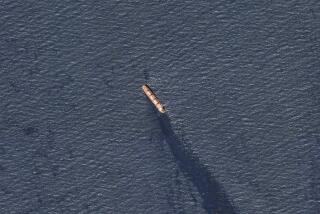No Victory at Sea
- Share via
If the experts on such matters are right, the explosion and fire aboard a Soviet submarine, which sent it 18,000 feet to the bottom of the Atlantic, raise no dangers of radioactive contamination of air or sea. That is reassuring. But it would be even more reassuring if an appropriate committee of Congress sought the judgment of a representative group of independent experts.
The Soviet government moved with admirable speed, compared with its early effort to cover up the nuclear disaster at Chernobyl, to announce that fire had broken out aboard one of its nuclear-powered submarines off Bermuda. Soviet leader Mikhail S. Gorbachev assured President Reagan in a message that there was no danger of a nuclear explosion, of radioactive contamination or of an accidental explosion of the sub’s 16 nuclear-armed missiles.
U.S. experts inside and outside of government subsequently reached the same conclusion, based on air and water sampling by U.S. forces in the area, the fact that there has been no radiation contamination from two U.S. subs that sank years ago, and on the fact that the Soviet sub went down in very deep water. Unlike the Chernobyl disaster, the reactor itself didn’t rupture; neither, apparently, did the missile warheads. That supposedly means that radioactive materials won’t be exposed to sea water for years and that the gradual release of radiation would be diluted in the ocean depths.
But the accident still serves as a spooky reminder of the potential hazards aboard nuclear submarines--especially Soviet submarines.
Soviet sailors are said to joke grimly that you can tell members of the Northern Fleet because “they glow in the dark.” U.S. intelligence sources say that the reactors aboard Russia’s nuclear subs do indeed have less protective shielding than their American counterparts.
On top of that, Yankee-class subs like the one that sank carry old-fashioned missiles using highly flammable liquid fuels instead of the less volatile solid rocket fuels used in American and newer Soviet subs. The accident last weekend apparently involved an explosion in a missile fuel system. As a retired U.S. admiral said Tuesday, “I would be terrified to put to sea in one of those things.”
The world could rest a bit more easy if it had answers to several questions. One is the degree to which worst-case accidents have been designed out of our own nuclear submarines. Another is whether a larger fuel explosion aboard that Soviet sub or any other might have ruptured the reactor containment vessel or the nuclear warheads. Is there even a theoretical possibility that a fire or explosion could cause nuclear missiles to be fired, either from U.S. or Soviet subs? Finally, how much longer do the Soviets intend to continue using liquid-fueled missiles aboard nuclear subs?
Clearly, it is irresponsible for the Soviets to keep liquid-fueled missiles aboard submarines in light of the demonstrated danger. In the wake of the Chernobyl accident the Kremlin took account of world opinion by promising to make their civilian power reactors safer. It is just possible that outside pressure might also influence them to assign a higher priority to safety in the design and arming of their submarines and other nuclear warships.
More to Read
Sign up for Essential California
The most important California stories and recommendations in your inbox every morning.
You may occasionally receive promotional content from the Los Angeles Times.










